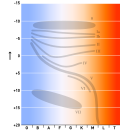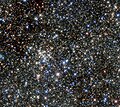Luminous blue variables (LBVs) are rare, massive, evolved stars that show unpredictable and sometimes dramatic variations in their spectra and brightness...
40 KB (4,911 words) - 18:00, 9 June 2025
Hypergiant (redirect from Blue hypergiant)
these are small except for two distinct instability regions where luminous blue variables (LBVs) and yellow hypergiants are found. Because of their high...
40 KB (4,532 words) - 02:23, 19 June 2025
giants Blue giants Bright giants Supergiants Red supergiant Hypergiants absolute magni- tude (MV) A blue supergiant (BSG) is a hot, luminous star, often...
21 KB (2,496 words) - 09:01, 10 June 2025
This is a list of luminous blue variable stars in order of their distance from Earth. The Large Magellanic Cloud (LMC) is around 163 kly distant and the...
26 KB (967 words) - 14:43, 8 April 2025
P Cygni (category Luminous blue variables)
Earth, it is a hypergiant luminous blue variable (LBV) star of spectral type B1-2 Ia-0ep that is one of the most luminous stars in the Milky Way. The...
16 KB (1,683 words) - 16:15, 30 May 2025
Supergiant (redirect from Blue-white supergiants)
Blue giants Bright giants Supergiants Red supergiant Hypergiants absolute magni- tude (MV) Supergiants are among the most massive and most luminous stars...
40 KB (5,378 words) - 22:07, 13 May 2025
NGC 3109 (section Luminous Blue Variable)
them. Although no supernovae have been observed in NGC 3109 yet, a luminous blue variable, designated AT 2018akx (type LBV, mag. 17.5), was discovered by...
11 KB (950 words) - 01:38, 20 April 2025
NGC 4559 (section Luminous Blue Variable)
supernova was visible starting 5 February 1941. NGC 4559 is home to the luminous blue variable AT 2016blu (also known as PSN J12355230+2755559, or as NGC 4559OT)...
7 KB (571 words) - 00:11, 14 June 2025
Sanduleak −69 202 (category Luminous blue variables)
that Sk -69 202 may have been a luminous blue variable in the recent past, although it was apparently a normal luminous supergiant at the time it exploded...
4 KB (347 words) - 16:10, 26 March 2025
2007). "Discovery of a Nearby Twin of SN 1987A's Nebula around the Luminous Blue Variable HD 168625: Was Sk -69 202 an LBV?". The Astronomical Journal. 133...
32 KB (2,428 words) - 14:09, 15 June 2025
class of variables is named after Beta Cephei. Classical Cepheids (or Delta Cephei variables) are population I (young, massive, and luminous) yellow supergiants...
51 KB (6,578 words) - 23:22, 23 May 2025
Stellar classification (redirect from Blue-white star)
symbols are used for white dwarfs than for other types of stars: Luminous blue variables (LBVs) are rare, massive and evolved stars that show unpredictable...
107 KB (11,666 words) - 14:52, 17 June 2025
Bomans, D. J.; Burggraf, Birgitta (2014). "Luminous and Variable Stars in M31 and M33. II. Luminous Blue Variables, Candidate LBVS, Fe II Emission Line Stars...
174 KB (10,733 words) - 19:46, 19 June 2025
Przybilla, Norbert; Nieva, M. -Fernanda (2011). "Red Supergiants, Luminous Blue Variables and Wolf-Rayet stars: The single massive star perspective". Bulletin...
9 KB (1,092 words) - 06:00, 2 June 2025
S Doradus (category Luminous blue variables)
roughly 160,000 light-years away. The star is a luminous blue variable, and one of the most luminous stars known, having a luminosity varying widely above...
28 KB (3,188 words) - 14:15, 2 November 2024
LBV 1806−20 (category Luminous blue variables)
LBV 1806−20 is a candidate luminous blue variable (LBV) and likely binary star located around 28,000 light-years (8,700 pc) from the Sun, towards the center...
9 KB (895 words) - 03:12, 23 December 2024
lives in the blue giant stage. Because O-type and B-type stars with a giant luminosity classification are often somewhat more luminous than their normal...
11 KB (1,486 words) - 01:16, 3 March 2025
Binary star (redirect from Eclipsing Variable Star)
well-established in all cases, it may be termed a "hot companion". The luminous blue variable Eta Carinae has been determined to be a binary star system. The...
68 KB (8,202 words) - 02:35, 23 March 2025
R71 (star) (category Luminous blue variables)
the constellation Mensa. It is classified as a luminous blue variable and is one of the most luminous stars in the LMC. It lies three arc-minutes southwest...
14 KB (1,514 words) - 03:20, 2 June 2025
AG Carinae (category Luminous blue variables)
constellation of Carina. It is classified as a luminous blue variable (LBV) and is one of the most luminous stars in the Milky Way. The great distance (20...
14 KB (1,477 words) - 20:56, 10 March 2025
time. The Pistol Star, a luminous blue variable is 1.6 million times brighter than the Sun making it one of the most luminous stars in the Milky Way. Figer...
4 KB (362 words) - 15:40, 22 May 2025
Iron star (section Blue supergiant)
FeII lines in its spectrum. They are potentially quiescent hot luminous blue variables. Eta Carinae has been described as a prototypical example. An iron...
5 KB (427 words) - 04:44, 5 June 2025
low-luminosity post-red supergiant luminous blue variables to collapse, most likely as a Type IIn supernova. Several examples of hot luminous progenitors of Type IIn...
201 KB (21,902 words) - 21:17, 21 June 2025
HD 37836 (category Luminous blue variables)
HD 37836 is a candidate luminous blue variable located in the Large Magellanic Cloud and one of the brightest stars in its galaxy. The star was first mentioned...
8 KB (790 words) - 09:15, 1 January 2025
theoretical models. Stars increase in luminosity as they age, and a more luminous star must radiate energy more quickly to maintain equilibrium. For stars...
5 KB (664 words) - 00:41, 16 March 2025
AE Andromedae (category Luminous blue variables)
Andromedae (AE And) is a luminous blue variable (LBV), a type of variable star. The star is one of the most luminous variables in M31, the Andromeda Galaxy...
10 KB (1,083 words) - 15:37, 20 September 2023
NGC 2363-V1 (category Luminous blue variables)
NGC 2363-V1 is a luminous blue variable star in the star-forming region NGC 2363, at the far southwestern part of the irregular galaxy NGC 2366 in the...
5 KB (413 words) - 20:08, 19 June 2025
Pistol Star (category Luminous blue variables)
Pistol Star (or V4647 Sagittarii) is an extremely luminous blue hypergiant star, one of the most luminous and massive known stars in the Milky Way. It is...
13 KB (1,288 words) - 14:35, 29 May 2025
the most massive and luminous stars, but it does have the distinction of hosting two of the extremely rare luminous blue variables, the Pistol Star and...
23 KB (2,110 words) - 03:01, 31 May 2025
HR Carinae (category Luminous blue variables)
HR Carinae is a luminous blue variable star located in the constellation Carina. It is surrounded by a vast nebula of ejected nuclear-processed material...
14 KB (1,509 words) - 16:38, 31 August 2024
























